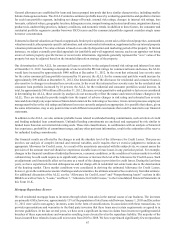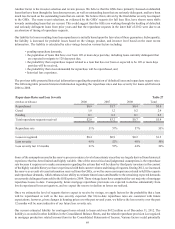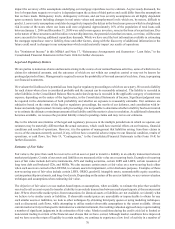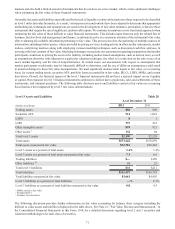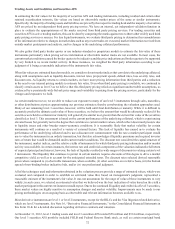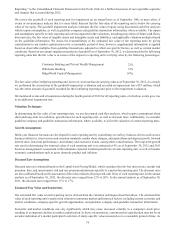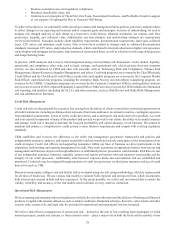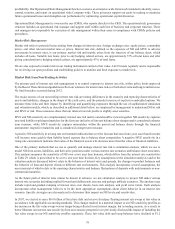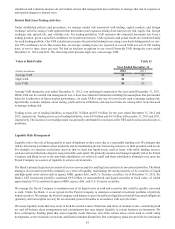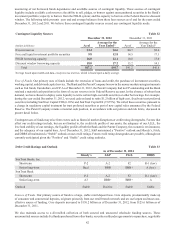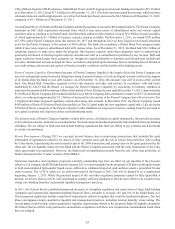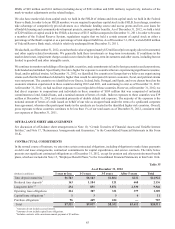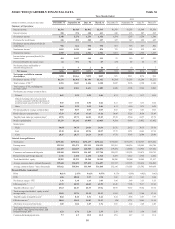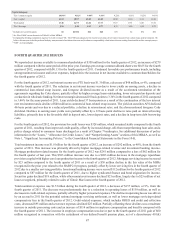SunTrust 2012 Annual Report Download - page 93
Download and view the complete annual report
Please find page 93 of the 2012 SunTrust annual report below. You can navigate through the pages in the report by either clicking on the pages listed below, or by using the keyword search tool below to find specific information within the annual report.77
Postretirement Healthcare Cost
Assumed healthcare cost trend rates also have an impact on the amounts reported for the other postretirement benefit plans.
Due to changing medical inflation, it is important to understand the effect of a one percent change in assumed healthcare cost
trend rates. If we were to assume a one percent increase in healthcare cost trend rates, the effect on the other postretirement
benefit obligation and total interest and service cost would be an increase of approximately $11 million and $1 million,
respectively. If we were to assume a one percent decrease in healthcare trend rates, the effect on the other postretirement
benefit obligation and total interest and service cost would be a decline of approximately $10 million and $1 million,
respectively.
To estimate the projected Postretirement Healthcare Benefit obligation as of December 31, 2012, we projected forward the
benefit obligations from January 1, 2012 to December 31, 2012, adjusting for benefit payments, expected growth in the benefit
obligations, changes in key assumptions and plan provisions, and any significant changes in the plan demographics that
occurred during the year, including (where appropriate) subsidized early retirements, changes in per capita claims cost,
Medicare Part D subsidy, and retiree contributions.
ENTERPRISE RISK MANAGEMENT
In the normal course of business, we are exposed to various risks. We have established an enterprise risk governance framework
to manage these risks and to provide reasonable assurance that key business objectives will be achieved. Underlying this
framework are limits, policies, processes, and procedures designed to effectively identify, monitor, and manage risk.
The Board is wholly responsible for oversight of enterprise risk governance. The BRC assists the Board in executing this
responsibility. Administration of the framework and governance process is the responsibility of the CRO, who executes this
responsibility through the CRM organization. The CRO reports to the CEO, and provides overall vision, direction, and
leadership regarding our enterprise risk management framework. Additionally, the CRO provides regular risk assessments to
Executive Management, the BRC, the Audit Committee of the Board, and the full Board, and provides other information to
Executive Management and the Board, as requested.
Our risk governance structure and processes are founded upon three lines of defense, each of which is critical to ensuring that
risk and reward in all activities are properly identified, assessed, and managed. The three lines of defense require effective
teamwork combined with individual accountability within defined roles. The first line of defense is comprised of all teammates
within our lines of business and geographies, and also includes select functional group activities. The first line owns and is
accountable for business strategy, performance, management, and controls within their business units and for the identification,
management, and reporting of existing and emerging risks. The second line of defense is comprised of Corporate Functions,
including CRM, and is responsible for independent governance and oversight of risk in the first line. These processes include
governance/framework design, establishment of policy and oversight of execution, and reporting. The third line of defense
is comprised of the Bank's assurance functions - Audit Services and Risk Review, which independently test, verify, and evaluate
management controls and provide risk-based advice and counsel to management to help develop and maintain a risk
management culture that supports business objectives.
Enterprise risk governance is supported by a number of risk-related, senior management committees. These governance
committees are responsible for ensuring effective risk measurement and management within their respective areas of authority,
and include the: CRC, ALCO, the CC, and the PMC. The CRC is chaired by the CRO and supports the CRO in measuring
and managing our aggregate risk profile. ALCO is chaired by the CFO, and provides management and oversight of market,
liquidity and balance sheet-related risks, and has the responsibility to optimize those risks in relation to the profitability of
the underlying businesses. The CC is also chaired by the CFO and provides management and oversight of our capital actions
and our CCAR program. PMC is chaired by the Wholesale Banking Executive and provides oversight of balance sheet
allocations to ensure that new asset originations and assets available for purchase in the secondary market meet our risk and
business objectives. PMC also oversees progress towards long-term balance sheet objectives. The CEO, CFO, and the CRO
are members of each governance committee to promote consistency and communication. Additionally, other executive and
senior officers of the Company are members of these committees based upon their responsibilities and subject matter expertise.
The CRO and, by extension, the CRM, establishes sound corporate risk processes that focus on identifying, measuring,
analyzing, managing, and reporting the risks that we face. At its core, CRM’s objective is to deliver sophisticated risk
management capabilities throughout the organization that:
• Identify, measure, analyze, manage, and report risk at the transaction, portfolio, and enterprise levels;
• Optimize decision making;


